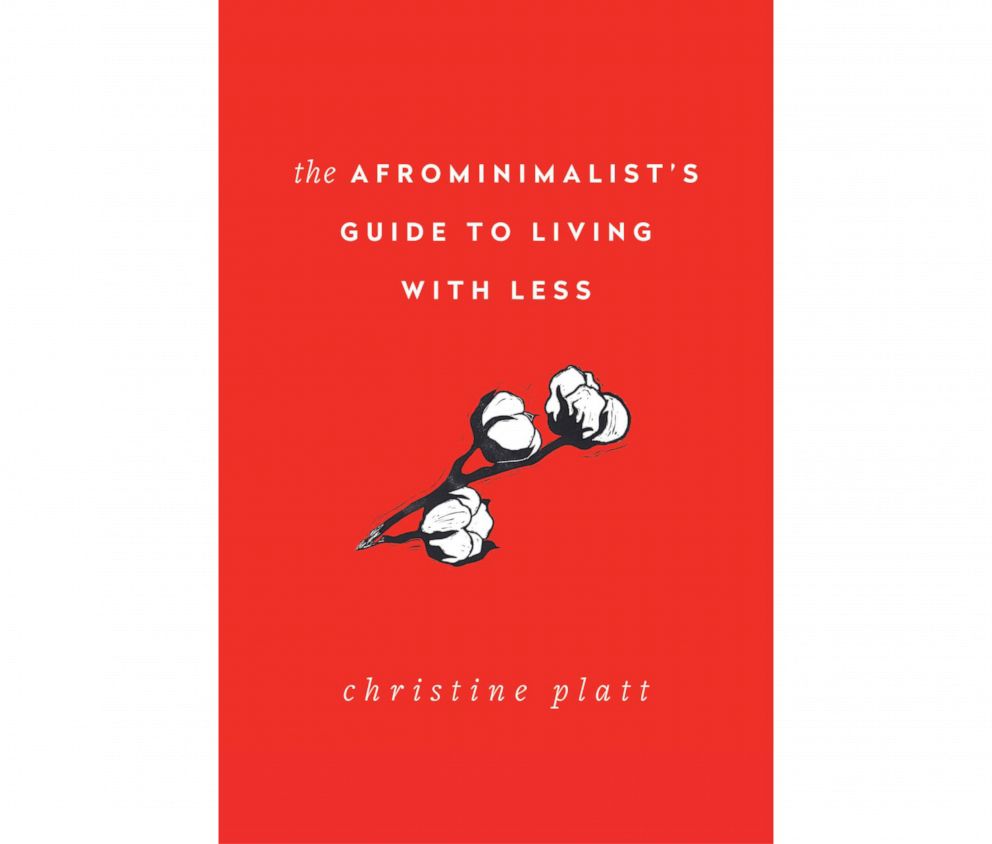'GMA' Buzz Pick: 'The Afrominimalist's Guide to Living with Less' by Christine Platt
Learn how to make space for what really matters with this book.
If you've finished our "GMA" Book Club pick this month and looking for something else to read, check out our digital series, "GMA" Buzz Picks. Each week, we'll feature a new book we're also reading this month to give our audience even more literary adventures. Get started with our latest pick below!
If you've ever wanted to learn how to live with less, consider this week's "GMA" Buzz Pick, "The Afrominimalist's Guide to Living with Less" by Christine Platt.
This week’s Buzz Pick is recommended by Mahogany Books in Washington, D.C.

In Platt's latest book, she teaches readers how to let go of what no longer serves them, pay it forward with the items they let go, become a mindful consumer and teaches readers how to create a personal, purposeful and sustainable wardrobe as well as home decor.
Platt, who first set out to live with less when it came to taming her closet, said she considered mainstream minimalism, but after realizing how it was unattainable for many, with the emphasis on barren aesthetics and an emphasis on all-white decor, she wanted to do things her way by curating a life of less influenced by the African diaspora.
For Platt, living with less is more than a decluttering regimen, but inspired by her own journey of celebrating the importance of history and heritage and giving readers permission to make space for what really matters.
"The Afrominimalist's Guide to Living With Less" is available now wherever books are sold.
Get started with an excerpt below and get a copy here.

'The Afrominimalist's Guide to Living with Less' by Christine Platt
In Christine Platt's "The Afrominimalist's Guide to Living with Less," Platt helps readers learn how to make space for what matters in their homes.
- $20.23
- $21.99
Read along with us and join the conversation all month long on our Instagram account -- GMA Book Club and #GMABookClub

*****
Minimalism: An Introduction
Although its origins are rooted in artistic design and expression, today minimalism is best known as a lifestyle trend that encourages simplicity. These days we talk about our homes, décor, productivity, wardrobes, and even our digital spaces as opportunities to practice minimalism. Regardless of the subject, the principles of the practice are intended to achieve a desired result: minimizing excess to ensure life is filled with only what matters.
But because the word "minimalism" has become almost synonymous with clean lines and a neutral, simplistic aesthetic, many people believe (incorrectly) that there is only one way minimalism can look. So, let's get one thing straight: Minimalism is a practice. It is a mindset. A choice. A lifestyle. And so much more than an aesthetic. You do not need to commit yourself to Scandinavian furniture and white walls in order to commit to the practice of living with less.
In its simplest form, minimalism requires you to be authentic and intentional about what you choose to keep and what you allow into your life. The "keep" part of the equation is often the focus of documentaries and other media, amplified by people gathering and sorting through their belongings to find what "sparks joy." Deciding what to keep is, indeed, important (and we'll talk more about that in Part Two, "The Process"), but it's not the whole story. How and why people acquire so many things, why we allow what we do into our lives is an aspect that is less commonly addressed. Instead, many practitioners create confusing rules and guidelines to prevent acquisitions, often setting expectations that seem unrealistic for the average person.
Good news: If these unofficial policies about minimalism seem unrealistic to you, it's because they are! In fact, trying to conform your home, wardrobe, and other personal aspects of your life to mirror someone else's is the antithesis of the practice. If the mindset of a minimalist is grounded in authenticity and intentionality, then your own lived experience of minimalism should be as varied and unique as we are. That is why I encourage anyone who wants to live with less to focus on authenticity over aesthetics.
We Are All Consumers
"We are all consumers, people who purchase and acquire goods for personal use. Our choices impact not only our own lives but also extend to the makers of these goods and their impact on the environment. The minimalist mindset is one of conscious consumerism."—Christine
As a lifestyle, minimalism means making a commitment to be a more conscious consumer. This act of intention requires you to move responsibly as you decide what to keep and allow into your life. This includes being honest about your needs and what makes you happy, and educating yourself about the true cost of your purchases beyond their price tags. To be a conscious consumer, you must be aware of how your choices impact not only your lifestyle and finances but the laborers producing these goods, as well as their environmental footprint. Our spending affects more than our wallets and what we acquire in our homes. Minimalism is an opportunity for us to be intentional in our consumption.
Just as my journey led me to a style that I like to call Afrominimalism, your journey will lead you to your own personal style. And keep in mind that it may even change over time.
Your journey to become a minimalist is a process of self- discovery that will not happen overnight. So, remember to be patient and don't rush to conform to an aesthetic that you think minimalism should look like. As you embrace the principles and practice of living with less, allow authenticity to be your guide. Your home décor, wardrobe, and other personal effects should be representative of your core values, but what values you choose and how you choose to reflect these areas of importance may take time. Despite the temptation of commodified simplicity, being authentic in your approach to minimalism is the only sure way to successfully embrace and maintain your new lifestyle. We have to start with ourselves.
Why You Have More Than You Need
I still remember the large piles of clothing sitting atop my bed. The numerous shoes and accessories scattered across the floor. And me, standing in the middle of the chaos, overwhelmed and sobbing, "I can't believe I have all this stuff!" It didn't help to know that I still had several more closets, bins, and baskets to conquer. It was such a sobering reality as I began my journey to live with less. There was no way to deny it any longer: I had more than I needed.
A recent article in the Los Angeles Times noted that the average American household has more than 300,000 items, a staggering statistic given that these families have fewer than three individuals.2 And although children in the United States account for 3.7 percent of the world's youth, they are the recipients of 47 percent of all toys and children's books. More people use their two-car garages for storage than to park their two cars. Let's face it: Most of us have a lot of stuff.
There are so many reasons we have more than we need. But often, even as we stare at piles of our belongings, trying to ac- count for how—the shopping sprees, tiny indulgences accumulated over the years, the gifts we received—we still don't really understand why. Which is exactly why this is where your journey to minimalism will start: by first identifying and understanding the reasons underlying why you have accumulated so much. Unless we understand the root causes of our overconsumption, we risk finding ourselves in the same situation time and time again.
*****
Excerpted from The Afrominimalist's Guide to Living with Less. Copyright © 2021, Christine Platt. Reproduced by permission of Tiller Press an imprint of Simon & Schuster. All rights reserved.







